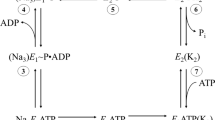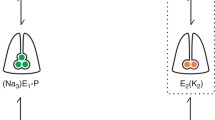Summary
The electrochemical properties of a widely accepted six-step reaction scheme for the Na+, K+-ATPase have been studied by computer simulation. Rate coefficients were chosen to fit the nonvectorial biochemical data for the isolated enzyme and a current-voltage (I–V) relation consistent with physiological observations was obtained with voltage dependence restricted to one (but not both) of the two translocational steps. The vectorial properties resulting from these choices were consistent with physiological activation of the electrogenic sodium pump by intracellular and extracellular sodium (Na+) and potassium (K+) ions. The model exhibited K+/K+ exchange but little Na+/Na+ exchange unless the energy available from the splitting of adenosine triphosphate (ATP) was reduced, mimicking the behavior seen in squid giant axon. The vectorial ionic activation curves were voltage dependent, resulting in large shifts in apparent Km's with depolarization. At potentials more negative than the equilibrium or reversal potential transport was greatly diminished unless the free energy of ATP splitting was reduced. While the pump reversal potential is at least 100 mV hyperpolarized relative to the resting potential of most cells, the voltage-dependent distribution of intermediate forms of the enzyme allows the possibility of considerable slope conductance of the pumpI–V relation in the physiological range of membrane potentials. Some of the vectorial properties of an electrogenic sodium pump appear to be inescapable consequences of the nonvectorial properties of the isolated enzyme. Future application of this approach should allow rigorous quantitative testing of interpretative ideas concerning the mechanism and stoichiometry of the sodium pump.
Similar content being viewed by others
References
Atkinson, D.E. 1977. Cellular Energy Metabolism and its Regulation. Academic Press, New York
Attwell, D., Cohen, I., Eisner, D.A. 1979. Membrane potential stability conditions for a cell with a restricted extra-cellular space.Proc. R. Soc. London B 206:145–161
Bockris, J.O'M., Reddy, A.K.N. 1970. Modern electrochemistry: An Introduction to an Interdisciplinary Area. Plenum Press, New York
Boudart, M. 1976. Consistency between kinetics and thermodynamics.J. Phys. Chem. 80:2869–2870
Brinley, F.J., Mullins, L.J. 1968. Sodium fluxes in internally dialyzed squid axons.J. Gen. Physiol. 52:181–211
Brown, H., Di Francesco, D., Noble, D., Noble, S. 1980. The contribution of potassium accumulation to outward currents in frog atrium.J. Physiol. (London) 306:127–149
Caldwell, P.C., Hodgkin, A.L., Keynes, R.D., Shaw, T.I. 1960. Partial inhibition of the active transport of cations in the giant axons ofLoligo.J. Physiol. (London) 152:591–600
Chapman, J.B. 1973. On the reversibility of the sodium pump in dialyzed squid axons. A method for determining the free energy of ATP breakdown?J. Gen. Physiol. 62:643–646
Chapman, J.B. 1982. A kinetic interpretation of “variable” stoichiometry for an electrogenic sodium pump obeying chemiosmotic principles.J. Theor. Biol. 95:665–678
Chapman, J.B. 1983. Thermodynamics and kinetics of electrogenic pumps.In: Electrogenic Transport. Fundamental Principles and Physiological Implications. M.P. Blaustein and M. Lieberman, editors. Raven Press, New York (in press)
Chapman, J.B., Johnson, E.A. 1978. The reversal potential for an electrogenic sodium pump: A method for determining the free energy of ATP breakdown?J. Gen. Physiol. 72:403–408
Chapman, J.B., Kootsey, J.M., Johnson, E.A. 1979. A kinetic model for determining the consequences of electrogenic active transport in cardiacmuscle.J. Theor. Biol. 80:405–424
Chapman, J.B., McKinnon, I.R. 1978. Consistency between thermodynamics and kinetic models of ion transport processes.Proc. Aust. Soc. Biophys. 2:3–7
Chapman, K.M. 1980. The sodium pump as a current source: Linear thermodynamic equations for the transmembrane potential and its transient responses to changes in transport rate.Physiologist 76:18a
Chipperfield, A.R., Whittham, R. 1974. Evidence that ATP is hydrolysed in a one step reaction of the sodium pump.Proc. R. Soc. London B 187:269–280
Daut, J., Rudel, R. 1981. Cardiac glycoside binding to the Na/K-ATPase in the intact myocardial cell: Electrophysiological measurement of chemical kinetics.J. Mol. Cell. Cardiol. 13:777–782
Fried, I. 1973. The chemistry of electrode processes. Academic Press, London
Gadsby, D.C., Cranefield, P.F. 1979a. Direct measurement of changes in sodium pump current in canine cardiac Purkinje fibers.Proc. Natl. Acad. Sci. USA 76:1783–1787
Gadsby, D.C., Cranefield, P.F. 1979b. Electrogenic sodium extrusion in cardiac Purkinje fibers.J. Gen. Physiol. 73:819–837
Garay, R.P., Garrahan, P.J. 1973. The interactions of sodium and potassium with the sodium pump in red cells.J. Physiol. (London) 231:297–325
Garrahan, P.J., Glynn, I.M. 1967a. Factors affecting the relative magnitudes of the sodium: potassium and sodium: sodium exchanges catalysed by the sodium pump.J. Physiol. (London) 192:189–216
Garrahan, P.J., Glynn, I.M. 1967b. The incorporation of inorganic phosphate into adenosine triphosphate by reversal of the sodium pump.J. Physiol. (London) 192:237–256
Gradmann, D., Hansen, U.-P., Slayman, C.L. 1981. Reaction kinetic analysis of current-voltage relationships for electrogenic pumps inNeurospora andAcetabularia.Curr. Top. Membr. Transp. 16:257–276
Guidotti, G. 1979. Coupling of ion transport to enzyme activity.In: The Neurosciences, Fourth Study Program. I.O. Schmitt and F.G. Worden, editors. pp. 831–840. MIT Press, Boston, Mass.
Hall, J.E., Mead, C.A., Szabo, G. 1973. A barrier model for current flow in lipid bilayer membranes.J. Membrane Biol. 11:75–97
Hammes, G.G., Schimmel, P.R. 1970. Rapid reactions and transient states.In: The Enzymes, 3rd ed. P.D. Boyer, editor. Vol. II, Ch. 2. Academic Press, New York
Hansen, U.-P., Gradmann, D., Slayman, C.L. 1981. Interpretation of current-voltage relationships for “active” ion transport systems: I. Steady-state reaction-kinetic analysis of class-I mechanisms.J. Membrane Biol. 63:165–190
Hassinen, I.E., Hiltunen, K. 1975. Respiratory control in isolated perfused rat heart. Role of the equilibrium relations between the mitochondrial electron carriers and the adenylate system.Biochim. Biophys. Acta 408:319–330
Hoffman, P.G., Tosteson, D.C. 1971. Active sodium and potassium transport in high potassium and low potassium sheep red cells.J. Gen. Physiol. 58:438–466
Jack, J.J.B., Noble, D., Tsien, R.W. 1975. Electric current flow in excitable cells. Oxford University Press, Oxford
Jakobsson, E. 1980. Interactions of cell volume, membrane potential, and membrane transport parameters.Am. J. Physiol. 238:C196-C206
Johnson, E.A., Chapman, J.B., Kootsey, J.M. 1980. Some electrophysiological consequences of electrogenic sodium and potassium transport in cardiac muscle: A theoretical study.J. Theor. Biol. 87:737–756
Jorgensen, P.L. 1980. Sodium and potassium ion pump in kidney tubules.Physiol. Rev. 60:864–917
Keizer, J. 1975. Thermodynamic coupling in chemical reactions.J. Theor. Biol. 49:323–335
Keynes, R.D., Swan, R.C. 1959. The effect of external sodium concentration on the sodium fluxes in frog skeletal muscle.J. Physiol. (London) 147:591–625
Kootsey, J.M., Johnson, E.A., Chapman, J.B. 1981. Electrochemical inhomogeneity in ungulate Purkinje fibers: Model of electrogenic transport and electrodiffusion in clefts.Adv. Physiol. Sci. 8:83–92
Lauger, P., Stark, G. 1970. Kinetics of carrier-mediated ion transport across lipid bilayer membranes.Biochim. Biophys. Acta 211:458–466
Lieberman, M., Sawanobori, T., Kootsey, J.M., Johnson, E.A. 1975. A synthetic strand of cardiac muscle. Its passive properties.J. Gen. Physiol. 65:527–550
Michael, L.H., Schwartz, A., Wallick, E.T. 1979. Nature of the transport adenosine triphosphatase-digitalis complex: XIV. Inotropy and cardiac glycoside interaction with cat ventricular muscle.Mol. Pharmacol. 16:135–146
Mitchell, P. 1977. Epilogue: From Energetic abstraction to biochemical mechanism.Symp. Soc. Gen. Microbiol. 27:383–423
Mobley, B.A., Page, E. 1972. The surface area of sheep cardiac Purkinje fibers.J. Physiol. (London) 220:547–563
Mullins, L.J., Frumento, A.S. 1963. The concentration dependence of sodium efflux from muscle.J. Gen. Physiol. 46:629–654
Rapoport, S.I. 1970. The sodium-potassium exchange pump: Relation of metabolism to electrical properties of the cell. I. Theory.Biophys. J. 10:246–259
Sachs, J.R. 1977. Kinetic evaluation of the Na−K pump reaction mechanism.J. Physiol. (London) 273:489–514
Scriven, D.R.L. 1981. Modeling repetitive firing and bursting in a small unmyelinated nerve fiber.Biophys. J. 35:715–730
Skou, J.C. 1957. The influence of some cations on an adenosinetriphosphatase from peripheral nerves.Biochim. Biophys. Acta 23:394–401
Skou, J.C. 1975. The (Na++K+) activated enzyme system and its relationship to transport of sodium and potassium.Q. Rev. Biophys. 7:401–434
Tanford, C. 1981. Equilibrium state of ATP-driven ion pumps in relation to physiological ion concentration gradients.J. Gen. Physiol. 77:223–229
Veech, R.L., Lawson, J.W.R., Cornell, N.W., Krebs, H.A. 1979. Cytosolic phosphorylation potential.J. Biol. Chem. 254:6538–6547
Author information
Authors and Affiliations
Rights and permissions
About this article
Cite this article
Chapman, J.B., Johnson, E.A. & Kootsey, J.M. Electrical and biochemical properties of an enzyme model of the sodium pump. J. Membrain Biol. 74, 139–153 (1983). https://doi.org/10.1007/BF01870503
Received:
Revised:
Issue Date:
DOI: https://doi.org/10.1007/BF01870503




